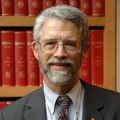The nuclear fire lit for the first time in the Trinity test 80 years ago kindled both fears and hopes. The fear, of course, was that the terrifying power of this new weapon would unleash horrifying destruction. While the United States had invented such a weapon first, it would surely not be the last – and as long as such weapons existed, humanity would be living with the danger of nuclear holocaust. The hope was that this fear would drive the world to new accords that would prohibit nuclear weapons and build the foundation for peace.
On the occasion of the 50th anniversary of nuclear weapons, Dr. Jack Gibbons, then President Clinton’s science advisor, delivered a speech I wrote outlining the “peril and a hope” posed by nuclear weapons, and the efforts at that more hopeful time to reduce the danger. Much of it is still relevant today.
Unfortunately, those hopes have not been fulfilled. On the 80th anniversary of the nuclear age, we face a more multi-polar nuclear world with thousands of nuclear weapons, intense animosity among nuclear-armed states, a weakened regime of nuclear arms restraint, and evolving technologies making nuclear balances ever more complex to maintain. Nevertheless, avoiding a new nuclear arms race would serve the interests of all the nuclear-armed states, and the world; there is still some hope that the nuclear-armed states will see that their interests lie in mutual nuclear restraint and measures to reduce the nuclear dangers the world faces.
I was barely more than a year old when, on 16 July 1945, the successful test of a fission bomb at the Trinity site in the Alamogordo Test Range in New Mexico launched the nuclear-weapon era. In the early years of a career at the intersection of science and public policy, though, I had opportunities to interact closely with a number of the scientists who played significant roles in the development of the world’s first nuclear weapons, including Hans Bethe, George Kistiakowsky, Victor Weisskopf, Edward Teller, Harrison Brown, Wolfgang (“Pief”) Panofsky, and Joseph Rotblat.
All of them except Teller later became proponents of nuclear arms control. Rotblat left Los Alamos as soon as Germany was defeated, not wishing to work any longer on a nuclear weapon to be used against Japan--a country that wasn’t known to be pursuing one. Brown was a founder in late 1945 of both the Bulletin of Atomic Scientists and the Federation of American Scientists. Bethe, Brown, Kistiakowsky, Panofksy, and Weisskopf were all early participants in the Pugwash Conferences on Science and World Affairs, which Rotblat had been instrumental in motivating and founding in the period 1955-57.
Late in his life Bethe called on scientists to “cease and desist” working on any aspect of nuclear-weapon development or manufacture. Panofsky, who had flown in the “chase plane” during the bombing of Hiroshima in August 1945, preceded me as Chair of the Committee on International Security and Arms Control of the U.S. National Academy of Sciences (in which role I served from 1994 until 2005).
The Pugwash Conferences received the Nobel Peace Prize in 1995 (jointly with Rotblat personally) “for their efforts to diminish the part played by nuclear weapons in international politics and, in the longer run, to eliminate such arms”. I gave the acceptance lecture on behalf of the Pugwash Organization following Rotblat’s acceptance lecture for the individual award. (I was Chair of the Executive Committee of the international Pugwash Council at the time.)
I learned an immense amount from the senior figures of the Manhattan Project that I had the pleasure of knowing. That knowledge served me well in my roles in the Pugwash Conferences, in helping the MacArthur Foundation establish its Peace Program, in advising Presidents Clinton and Obama on nuclear-weapon issues, and in co-founding the Managing the Atom Project with Steve Miller and Henry Lee when I joined the Kennedy School in July 1996.
Over the decades, many people and organizations have attempted to put the nuclear genie at least partially back in the bottle. As noted here, the people working toward that goal included quite a few of the key scientists—many more than I have mentioned--involved in developing these weapons. But despite all the effort, eighty years after Trinity we live in a world with over 12,000 nuclear weapons in the possession of nine nations. That is enough to destroy modern civilization many times over. It must be hoped that the next generation working to rein in the nuclear-weapon menace will be more successful than their predecessors.
The U.S. nuclear weapons testing program had profound and long-term human and environmental costs, so it should not simply be viewed as a technical achievement. From the 1940s through the 1960s, the US conducted hundreds of above-ground nuclear tests at the Trinity site, as well as in Nevada and the Pacific, leaving a legacy of radiation exposure that harmed thousands of workers in the defense industry, as well as civilians who lived downwind of the test sites. These consequences were largely unacknowledged at the time and only gradually addressed decades later, as people came forward to testify and give evidence of the damages.
In the western United States, some 600,000 people in at least 11 states were exposed to dangerous levels of radiation. Many of these individuals, including uranium miners, test site workers, truck drivers and civilians living in affected areas, developed cancers, thyroid diseases, pulmonary fibrosis and other radiation-linked illnesses. In response, Congress eventually created reparatory compensation programs such as the Energy Employees Occupational Illness Compensation Program (EEOICP) and the Radiation Exposure Compensation Act (RECA). Together, these programs have already paid out more than $35 billion in benefits to some 180,000 individuals and their families and descendants (and are still processing new claims). In the Pacific, U.S. nuclear testing devastated entire communities. Tests conducted in the Marshall Islands between 1946 and 1958 rendered several islands uninhabitable and exposed local populations to massive doses of radiation. The U.S. government acknowledged responsibility through the “Compact of Free Association” and established the Marshall Islands Nuclear Claims Tribunal, providing financial compensation and health care support. (These figures do not include the catastrophic toll of the nuclear bombings of Hiroshima and Nagasaki).
Consequently, one of the most complex and often overlooked legacies of the Trinity test and the U.S. nuclear research and testing program is the significant harm inflicted on American citizens, Pacific islanders, and future generations. The establishment of compensation programs decades later was based on recognition of government responsibility, documentation of harm, and provision of reparatory payments rooted in moral obligation. These precedents challenge the notion that nuclear advancement was cost-free and suggest that the ethical implications of national security policies deserve greater scrutiny and public awareness.



